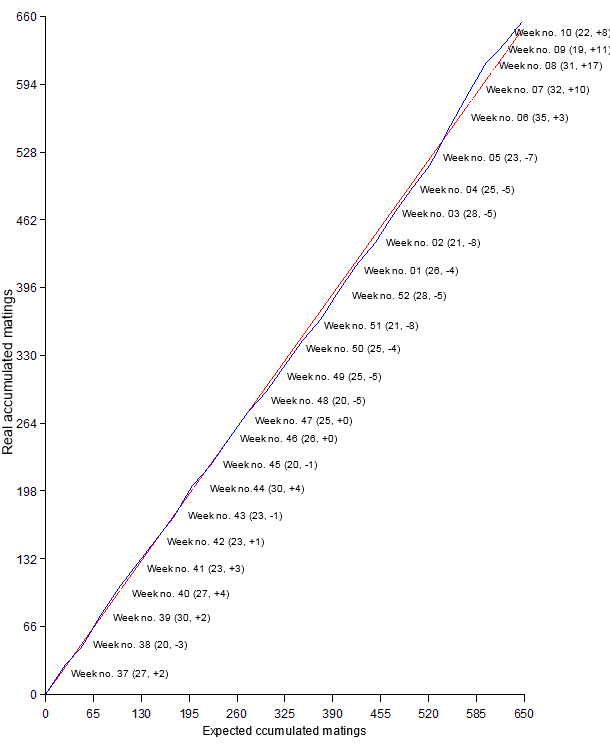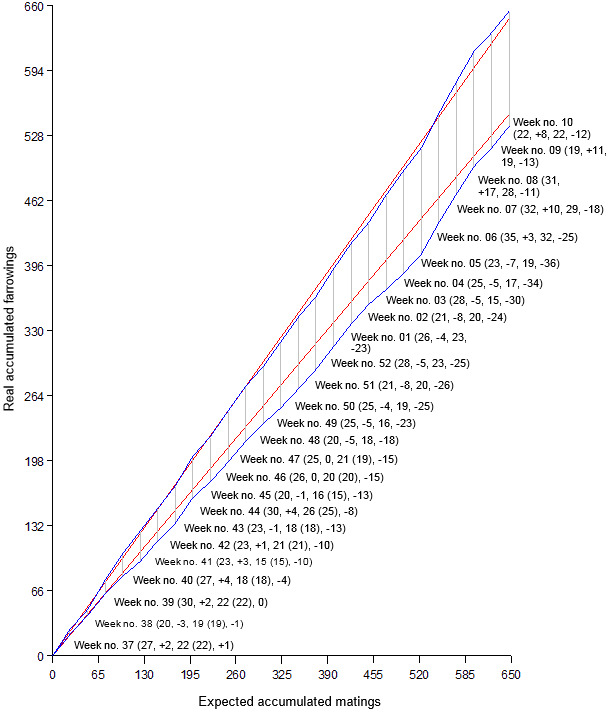The number of places in a farm is constant, and if we want to optimise their use we must make that the number of animals keeps as near as possible to the number of ideal places that must be occupied (that are not 100%, because there must always be a margin for movements, cleaning and disinfection). If we deviate too much from these goals we will encounter problems that will affect the production efficiency, and therefore the financial efficiency (overcrowding, movements of animals at the wrong moment, underusing of the facilities, etc.).
In order to keep the censuses of the different kinds of animals constant, the flows of pigs (movements of animals between different areas of the farm) must be constant. This is, we must keep the production pace of the farm.
The first step will review is how to calculate the production pace of the farm, and the second one how to keep it:
1.- Calculation of the production pace.- The perfect moment for setting the production pace is the moment of the mating, because it is the only item on which we can have influence, by mating more or less animals (obviously, we cannot have influence on the moment of the farrowing nor on the weaning).
In order to calculate the number of matings per period we need three pieces of information that are easy to calculate:
- Census on our farm.
- Farrowings/productive sow/year.
- Farrowing rate.

Let us see an example. If we want to know the number of matings/week on a farm with 500 productive sows with 2.35 farrowings/sow/year and a farrowing rate of 80%, the calculation would be:
- 500 productive sows x 2.35 farrowings/sow/year = 1,175 farrowings/year
- 1,175 farrowings/year/0.8 (farrowing rate) = 1,469 matings/year
- (1,469 matings/year/365 days) x 7 days = 28 matings/week
So, the goal on this farm would be to mate 28 sows every week. It is important to be able to check if we are attaining this goal and, if not, to control de deviation in order to be able to predict the variations in the flows of animals. In order to do this it is very useful to be able to have, weekly, a report as the following one:
Cumulative matings graph
655 matings between 8th September 2008 and 8th March 2009 (matings per week goal: 25)
Assuming a farm size of 460; 2.40 litters/productive sow/year, and a farrowing rate of 85.0%

In this report the number of the real and expected matings are compared, and the positive or negative deviation with respect to the goal is calculated weekly. Going one step further, we can also make calculations with respect to the farrowings goal and the expected farrowings, as we can see below:
Cumulative matings goal
655 matings between 8th September 2008 and 8th March 2009 (average of matings/week: 25; farrowings/week: 21)
Assuming a farm size of 460; 2.40 litters/mated sow/year, and a farrowing rate of 85.0%

In this case we can see that, although the matings goal is met with a high accuracy, the expected farrowings deviate from the goal, because the farrowing rate of the farm is lower than the one that was used for the calculations of the goals (80%).
2.- Keeping the production pace.- In the weekly matings, we will find three kinds of sows: weaned sows, sows that have returned to oestrus, and gilts. Let us see how to control the three groups of animals in order to attain the matings goal.
a) Weaned sows.- In order to know the number of weaned sows available for mating we must know the number of sows that will be weaned during each period: not only the number, but their distribution according to their age and productivity, in order to foresee the sows that are going to be culled and which ones will be available for the matings, as can be seen below:
23 (1) expected. Week no. 11, 2009
| ID | Farrrowing | Expected date |
Mating no. | Average no. born alive |
Average no. weaned |
Average interval between farrowings |
| 990 | 0 | 09 Mar 2009 | 1 | 12 | - | - |
| 991 | 0 | 10 Mar 2009 | 1 | 10 | - | - |
| 550 | 4 | 12 Mar 2009 | 1 | 13.4 | 9 | 154.5 |
| 562 | 4 | 12 Mar 2009 | 1 | 12.25 | 9 | 153.67 |
| 718 | 3 | 12 Mar 2009 | 1 | 11.5 | 9.33 | 145.67 |
| 725 | 3 | 12 Mar 2009 | 1 | 10 | 9 | 143 |
| 751 | 2 | 12 Mar 2009 | 2 | 11.67 | 9 | 198.5 |
| 806 | 2 | 12 Mar 2009 | 1 | 11.33 | 8.5 | 157.5 |
| 821 | 2 | 12 Mar 2009 | 1 | 11.67 | 9.5 | 149 |
| 840 | 2 | 12 Mar 2009 | 1 | 10.67 | 9.5 | 140.5 |
| 459 | 5 | 13 Mar 2009 | 1 | 10.17 | 10.2 | 155 |
| 519 | 4 | 13 Mar 2009 | 1 | 9.8 | 9.25 | 169 |
| 575 | 4 | 13 Mar 2009 | 1 | 10.25 | 8.75 | 146.33 |
| 719 | 3 | 13 Mar 2009 | 1 | 11.75 | 7 | 146.67 |
| 802 | 2 | 13 Mar 2009 | 1 | 10.67 | 9 | 147.5 |
| 828 | 2 | 13 Mar 2009 | 1 | 10.33 | 9 | 146.5 |
| 829 | 2 | 13 Mar 2009 | 1 | 10.67 | 8.5 | 146.5 |
| 841 | 2 | 13 Mar 2009 | 1 | 13 | 8.5 | 139.5 |
| 905 | 1 | 13 Mar 2009 | 1 | 10 | 9 | 139 |
| 906 | 1 | 13 Mar 2009 | 1 | 8 | 8 | 141 |
| 966 | 0 | 13 Mar 2009 | 2 | 7 | - | - |
| 992 | 0 | 14 Mar 2009 | 1 | 15 | - | - |
| 993 | 0 | 14 Mar 2009 | 1 | 7 | - | - |
We must know the distribution of the sows that are going to be weaned at least two-three months beforehand, in order to plan the handling of the gilts.
b) Gilts.-The gilts must help to adjust the number of matings to the goal. If we know, well beforehand, the number of gilts that are to be mated, we can modify their handling (flushing, increase of the entry of animals, leaving heats to go by) in order to adapt to the number of matings needed.
c) Sows that have returned to oestrus.- This is the group on which we can exert the lowest control. In this case the only thing that we can do is to foresee the seasonal effect: during the end of summer and autumn this group will probably increase. During this time span it is recommendable to increase the matings goal per period of time by 5%, foreseeing the possible decrease in the farrowing rate from these matings (because the important thing is not to have the same number of matings/period, but the same number of farrowings/period and, as a consequence, the same number of weanings/period).
In short, we can conclude that if we have updated information regarding the farm it is possible to control the production pace sufficiently in advance and with the required precision, so it does not control us, but it is us who control it.




